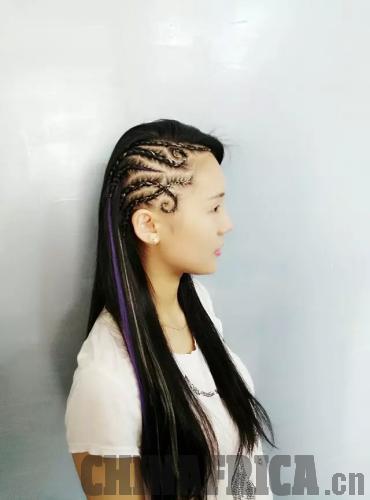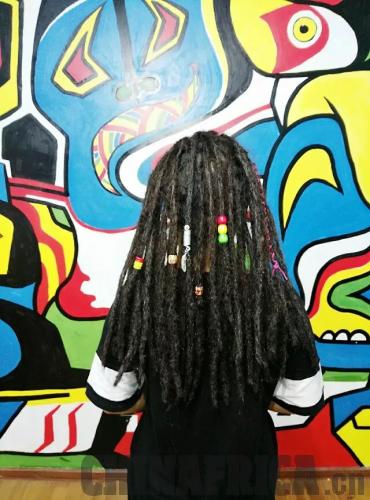|  
When Chinese singer Deng Ziqi appeared in a variety show on Chinese television last year, she caught the eye for an additional reason. Deng had chosen to do her hair in the African micro braid style - a cluster of tight braids braided together again, giving her an exotic look. It was yet another instance of Chinese stars going for the flamboyant African hairstyle. In 2012, Chinese actress Li Xiaolu dazzled the Paris Fashion Week with the same braided hair.
Are micro braids going to be the next hot trend in China? Yang Linyuan, hairdresser extraordinaire who has learned the art of braiding in Senegal, is hoping they will be.
"There is a huge demand for African braids in China," Yang told ChinAfrica. "A lot of people are interested in African things, including African braiding."
Yang returned to Zhengzhou, capital of central China's Henan Province, from Senegal in June 2014 to open his African braiding training institution, the first in the city.
Tress point
Yang's interest in African braiding grew through a circuitous route. "I got to know Africa through my brother, who is running a business in Senegal," he explained.
At the beginning, he was busy helping out his brother to run a shop. During his stay, he saw a variety of innovative hairstyles. "I particularly liked the braids but there weren't any professional institutions teaching the art where I lived."
He had to put his plan to learn braiding on hold for two years. However, the time was put to good use as he learned to speak French to cross the language barrier in Senegal. He also acquired an appreciation of the local people's playing of the famed African drums. With his new language skills, his social life improved and he began to go to picnics and barbecues with the locals.
Fate handed him a break when he discovered an American was teaching African braiding techniques. Yang signed up for classes without hesitation though finding time was a chore.
"I went to my teacher's studio twice or thrice a week," he said. He chose the afternoons when the hot sun kept people indoors and the shop had few buyers. It took him over six months to learn the intricate art. Then he began to practice on his own, integrating creative ideas for greater artistic effect.
Coiled for action
Once he had mastered the art, he planned the next course: he would return home and promote the African hairstyle there.
"In Europe and the United States, you have African braid specialists engaged in this industry but in China, there aren't any people or institutions." The braiding art came from Africa but it was actually in the United States where it blossomed, he said, with a plethora of American research institutions focusing on African hairstyles alone.
Yang decided to seize the vacuum in the Chinese market and introduce fashionable young Chinese to the charm of African braids. He said the market potential has begun to increase after Chinese stars started adopting African braiding elements and the art began to gather more and more fans in China.
The two training courses he gave have boosted his confidence. "My students come from all over the country," he said. "They are lawyers, college students, white-collar workers and artisans. A lot of people are interested in African braiding."
However, Yang has encountered some obstacles too. Asians and Africans, he has realized, have a different attitude toward aesthetics. The majority of Asians prefer a coiffured look, regarding the African braids as a bit wild. "Asians tend to be conservative, so what most people seek is something that is stylish but not that exaggerated," said Yang. "Based on Asian aesthetic characteristics, I have already made a lot of improvisations."
Pricing is another factor as potential customers fear the style could be expensive. Yang charges 150 yuan ($25) to do micro braids on one side, 500 yuan ($82) for a full head. He said the price is on par with the market price. Training sessions are more expensive, sometimes running into hundreds of dollars. He added that the public may balk at the price tag but that too is in line with market demand and rules.
Li Songyu, a lawyer from Zhengzhou, came to Yang after seeing his advertisement. "A full head of braids doesn't quite suit my image as a lawyer," she said. "So I chose a relatively conservative side braid style, which is fantastic."
But there are others who dig the wild look. A college student from Guangzhou, capital of south China's Guangdong Province, who preferred not to be named, was one of them. "I read about his agency online," she said. "I hadn't expected they actually do the style. It is pretty nice."
Loyal customers, including those coming to learn the technique, include tattoo artists and hairdressers; the latter are optimistic the style will catch on in China.
Growing roots
Ambitious Yang's ultimate goal is not one single training institution. "African braiding is not yet an industry in China but just a niche market. I am eager to develop it so that more people understand this different culture and accept it," he said. "Quite a number of people in China love African braiding but the majority do not really possess the skills. Braiding is a kind of craftsmanship."
While some websites teach how to braid hair the African way, Yang finds the techniques outdated. His plan is to open more training schools and tap into other channels, like collaborating with salons, to promote the African braiding technique. And with it, promote African culture. |